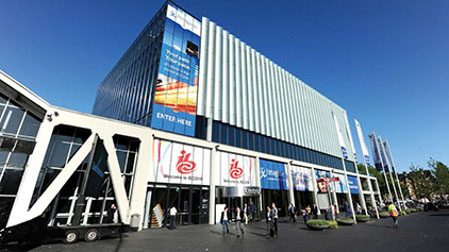AMSTERDAM—IBC 2017 opened today in Amsterdam with a rich lineup of conference topics, many aimed specifically at exploring what is and what can be in the way television is acquired, transported, managed, produced and ultimately distributed to an audience that’s evolving how it consumes media.

Beyond the seven conference program streams and keynote track, this year’s industry gathering at the Amsterdam RAI Exhibition and Convention Center will host some 1,700 exhibitors in 15 halls Sept. 15-19 -each with its own unique offering.
As at other recent industry gatherings, a major theme at IBC 2017 will be the progress individual vendors and the standards community has made on IP as a real-time, uncompressed transport alternative to baseband video standards.
The IP Showcase will present an interoperability demonstration of technology from more than 50 vendors using the SMPTE ST 2110 draft standard and Advanced Media Workflow Association (AMWA) Network Media Open Specification (NMOS).
Outside Hall 10 in Conference Room E106, the showcase will host the biggest IP interop ever attempted, said Scott Barella, CTO of Utah Scientific, a showcase participant.
Education on all things IP for media will be an important component of IBC 2017.
For instance, Andy Rayner, chief technologist at Nevion, will present the “Essential Element of the Evolution to Essence” Sept. 15. He is expected to discuss SDI, SMPTE ST 2022-6 and ST 2110.
The professional video industry's #1 source for news, trends and product and tech information. Sign up below.
Utah Scientific’s Barella is hoping to meld a degree of lightheartedness with serious IP education during two presentations of “The Hitchhiker’s Guide to IP” (Sept. 17 and again on Sept. 19).
“The idea is right from the novel,” he said. “I want to offer a 50,000-foot view of IP, a 10,000-foot view and then a closer look with an edge of humor.”
The presentation will place a special focus on working in a mixed SDI-IP environment, he added.
In their booths, many of the vendors leading the charge into IP are expected to focus on practical implementations that are being deployed today and will shape the future.
For example, Imagine Communications will feature its Selenio Network Processor, “a pure media microservices cloud platform” for public cloud or private datacenter use, said the company’s chief marketing officer Glodina Connan-Lostanlen.
The solution offers all major microservices modules needed for ingest and playout, and users can customize the platform to their unique workflow requirements by their module selection, she added.
Practical cloud-based deployments is also an important focus at the Snell Advanced Media (SAM) stand.
The company will show live channel deployment on Amazon Web Services (AWS) and will demonstrate how broadcasters can spin up and spin down channels as needed with its ICE SDC, the big brother of the company’s CiaB solution.
SAM also will highlight its turnkey IP routing solutions with support for SMPTE ST 2110 and how it has successfully deployed IP for remote production of the 2017 UEFA European Under-21 Championship Final in UHD.
Virtualization of media workflow will be among the key developments at the Grass Valley stand, said Jan Pieter van Welsem, company VP sales and marketing, EMEA.
“We have built a framework to have a real cloud-based architecture based on microservices,” he said. The approach offers broadcasters “flexibility and agility” in the way they manage channels by leveraging the cloud, he added.
Evolution of its GV Stratus video production platform will be another major development. “Stratus is becoming much more open” and moving to become a “services-type, data-based system,” said van Welsem.
Ross Video and Evertz are teaming up to show a joint implementation of AMWA NMOS. The demonstration will focus on the Evertz Magnum orchestration and control system directing Ross Video’s Raptor-Edge-IP gateway via the AMWA IS-04 and IS-05 specifications for NMOS discovery, registration and connection management.
However, IP in media is not the sole focus of technology at IBC 2017. For example, German research institute Fraunhofer will be highlighting the success of MPEG-H Audio as the audio codec for ATSC 3.0 4K television in South Korea.
Fraunhofer also will present the latest developments in the new JPEG XS standard, a lightweight, low-latency imaging coding system with support for video up to 8K. Dr. Siegfried Fobel is giving attendees an introduction to JPEG XS during his paper session “Beyond HEVC – How to build an even better codec.”
NHK will whet the appetites of broadcasters of what is truly possible in the living rooms of viewers at the IBC Future Zone. There, Japan’s national public broadcaster is demonstrating an 8K living room of the future.
Also Read:
Phil Kurz is a contributing editor to TV Tech. He has written about TV and video technology for more than 30 years and served as editor of three leading industry magazines. He earned a Bachelor of Journalism and a Master’s Degree in Journalism from the University of Missouri-Columbia School of Journalism.

